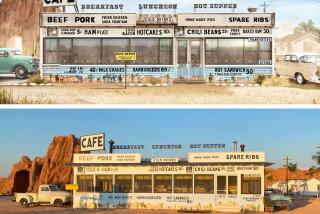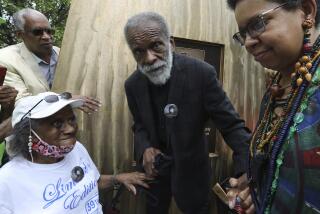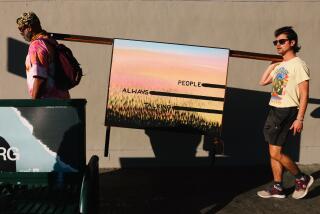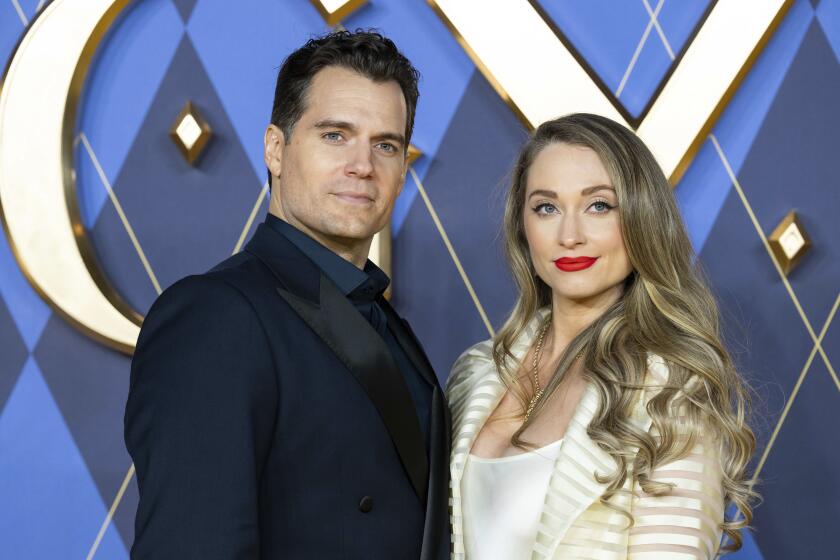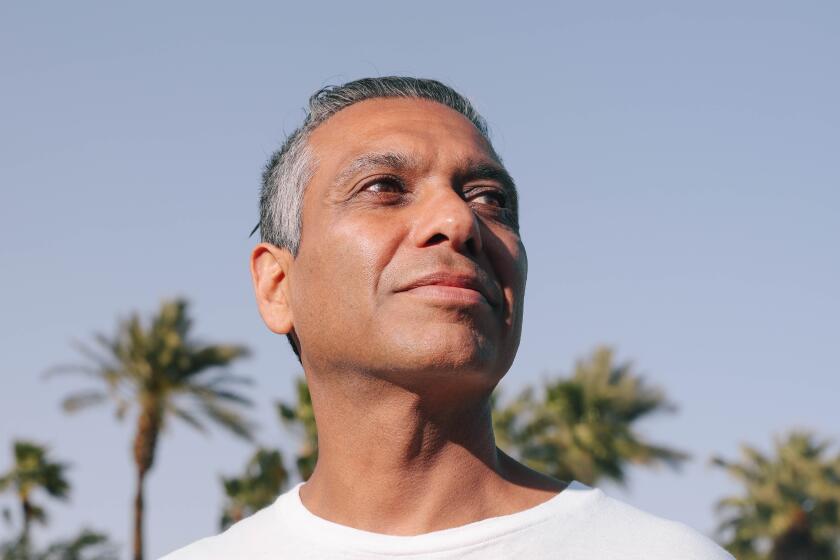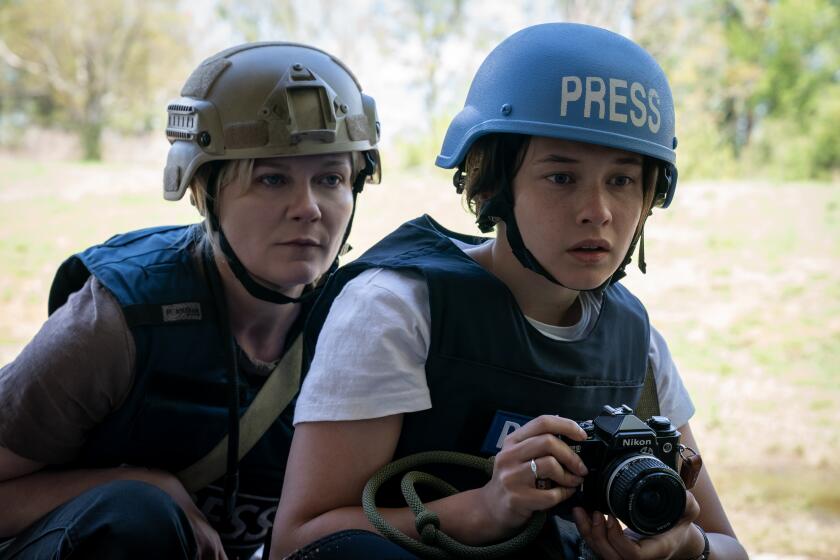James Turrell shapes perceptions
FLAGSTAFF, Ariz. — Flying a couple of thousand feet above a volcanic field in Arizona near the Painted Desert, it’s fairly easy to spot the extinct volcano known as the Roden Crater.
It stands alone in the field, apart from hundreds of other volcanoes. It shows signs of being a manmade monument, with paths winding around it, a small building with the horizontal thrust of a Neutra home embedded in one side and an entrance nearby.
And down in the center of the crater’s bowl, a 44-foot-wide concrete ring surrounds a large hole — looking up like a giant, unblinking eye.
FULL COVERAGE: 2013 Spring arts preview
You can imagine people thousands of years from now puzzling over its function, much the way people today wonder about Machu Picchu or Stonehenge. Was the eye of the crater a symbol of political power or a site of a religious ritual? Was the plaza surrounding it a stage for some sort of sacrifice?
As contemporary art disciples today know, the Roden Crater is actually an epic artwork in progress by James Turrell, who turned 70 this month and has a snowy white beard to go with it.
Turrell has devoted nearly 40 years and a good part of his income to the crater, and he’s completed construction on only about one-third of his plans. The goal is to transform the crater into what he calls “a naked-eye observatory” for viewing astronomical events.
He has moved tons of earth to subtly reshape the crater rim and bowl. He has built assorted chambers and tunnels inside for viewing celestial events like sunsets, solstices, solar eclipses and lunar standstills, framing them as images worth contemplating every bit as much as a starry night by Van Gogh.
In this way, the astronomical observatory doubles as art installation, designed to sharpen our patterns of attention and perception.
PHOTOS: Arts and culture in pictures by The Times
“You could say I’m a mound builder: I make things that take you up into the sky. But it’s not about the landforms,” said Turrell, known as a pioneering Light and Space artist as opposed to an earthworks artist like Robert Smithson or Michael Heizer. “I’m working to bring celestial objects like the sun and moon into the spaces that we inhabit.
“I apprehend light — I make events that shape or contain light.”
He also has some more worldly events on his mind these days. On May 26, a much-awaited retrospective of his work opens at the Los Angeles County Museum of Art. Also this month Turrell’s L.A. gallery Kayne Griffin Corcoran is opening a new space on La Brea, designed by the artist, with a show that documents the evolution of the crater from early plans in 1976 to today. It includes photographs, drawings, blueprints and models as well as actual tools used in the process — such as his aerial camera.
The following month, Turrell takes over the Guggenheim Museum rotunda in New York designed by Frank Lloyd Wright, creating a site-specific work using colored LED lights along with natural light from the skylight. Also in June, the Museum of Fine Arts, Houston, opens an exhibition showcasing his works, large and small, from its collection.
Alison de Lima Greene at the Houston institution said Turrell has been making important museum installations since his breakthrough Pasadena Art Museum show in 1967, when “he was the first artist to put on public display an exhibition where light was disembodied from any objects.”
CHEAT SHEET: Spring Arts Preview
These installations, she said, “allow viewers to reconnect with the joy of pure perception and the beauty of pure light.”
But the crater itself is very much in progress and closed to the public. Early on, Turrell announced that the crater would be finished by 1990, but funding dried up and his plans grew only more ambitious.
Later, the target for opening it to the public became 2000. It was not to be. Finally, the last time Turrell or his supporters went on record talking about a completion date, the goal was 2011, when the LACMA show was first scheduled.
But construction on new areas has lagged, and one major project — an 854-foot-tunnel designed to deliver multiple perceptual effects — suffered delays after contractors allegedly cut corners.
Nobody volunteers a date any more.
While driving his dusty dark blue Ford pickup truck through Flagstaff, some 40 miles southwest of the crater, Turrell wryly addressed whether his life’s work would ever be done.
“I firmly said I was going to finish in the year 2000, and I hope to keep to that,” he said with a flicker of a grin.
“It’s like one of your friends who never finished their thesis. What can I say?
“A lot of art you just stop, you don’t obsess over it. But I’ve had a bit of OCD, so I wanted to use it to my advantage,” he added lightly.
PHOTOS: Arts and culture in pictures by The Times
Clinical features of obsessive-compulsive disorder? “That would be my wife’s contention, yes,” he said, referring to his third wife, artist Kyung-Lim Lee.
But there is now a detailed plan in place so the crater could be finished without the artist if necessary.
This, along with completing the tunnel, is Turrell’s biggest accomplishment on the project this decade, said Richard Andrews, who curated the upcoming gallery show and serves as the president of the Skystone Foundation, which supports work on the crater.
“In the last four years since the Great Recession, when fundraising has been so difficult, that’s what we have focused on, completing all the design drawings,” he said. “His plans are now all buildable and permit-able. You literally could build from them.”
And Turrell himself, who moves more slowly than he used to but speaks just as quickly, sounded optimistic. He used to sign emails with a tag line, “Sooner or later … Roden Crater.” Now, he has a new slogan: “Sooner than later, Roden Crater.” His L.A. gallery is using it as the title of its upcoming show and printing the line on T-shirts for sale.
Turrell was discussing the history and future of the crater while driving to the airport hangar in Flagstaff where he keeps his own planes. He had eight planes there, all antique, which he repairs himself.
“There was a time when I restored antique planes to support my art habit. Now I find that my art habit doesn’t quite support my flying habit as well,” he says.
The habit dates to childhood. His dad was an aeronautical engineer who ran the technical program at Pasadena Junior College, now Pasadena City College. (His mother was a Quaker, and this blend of science and faith is much discussed in interpretations of his work.) He has early memories of flying with his father, who died when he was 10, and got his pilot’s license at age 16.
He continued his hobby during college, as a perceptual psychology student at Pomona College. Later, registered as a conscientious objector, he flew Buddhist monks out of Chinese-controlled Tibet. Some writers have suggested it was a CIA mission; Turrell will say only that it was “a humanitarian mission” — and that he found “some beautiful places to fly.”
In any event, he enjoyed flying as a way to escape the maze of streets (pilots call nonpilots “ground-pounders,” he said) and see things from “plan view.” The cockpit became a sort of surrogate studio — “I do some of my best observing in the plane.”
From 1966 to 1974, his other studio was on Main Street in Santa Monica. He transformed the building into an installation in its own right by cutting holes in walls and window coverings to focus and let in light — like the beams from passing cars. He also made his earliest light projection pieces there, creating illusions of solid geometric shapes like cubes. But developers had other plans for the building, and he was sent an eviction notice in 1974. (There is now a Starbucks in its place.)
So when he received a Guggenheim grant that year, he spent months flying from the Pacific to the Rockies searching for an outdoor site where he could make even more ambitious statements with light.
He found the Roden Crater, named after an early owner, William Rhoden, and made an impromptu landing beside it in his single-engine, six-seater Helio Courier. (“It has a very short takeoff and landing. So you can land in the desert without an airstrip,” Turrell said.)
He was drawn above all to its form. “It could have been a volcano or butte or raised mesa situation. I just knew I wanted this height and to make a bowl-like shape.”
“There are different stages when you fly,” he explained. “The first stage is the dollhouse effect, seeing everything on Earth like it’s a model. Suddenly all of your concerns seem very small.”
“The second stage at 400 to 600 feet is when it looks like the Earth curves in the wrong direction, curving up to the horizon. Then around 50,000 feet, you see the curvature of the Earth in the right direction.”
You can experience that second stage by standing on the cinder covering the rim of the crater, which reaches about 600 feet above ground level. Look at the land below and it seems to curl up gently at the edges of your field of vision, like a sticker losing its adhesive.
Then, climb down into the bowl of the crater and you can experience “celestial vaulting” — a term Turrell borrowed from art history. Lay down on one of four limestone benches that he has precisely positioned and angled around the eye of the crater. Look up at the sky, and it no longer appears as a flat expanse stretching above you but “vaulted”: It seems to curve over you, while the Earth below curves up to meet the sky, almost as if you were caught inside a snow globe.
While his scale is epic, his goal is intimate: to heighten our sensory connection to the cosmos. “I want this universe that we are in to become part of our personal space, part of our lived-in territory,” Turrell said. “I’m looking for a grandeur that does not belittle you.”
Inside the volcano, different chambers offer different experiences that vary with the time of day and weather conditions. Many of the chambers are dark, so our pupils open. “We weren’t made for this daylight,” he said. “It’s in twilight, in the light of the caves, where we see the best.”
One of the most dramatic experiences is the 854-foot-long darkened tunnel, which leads to a room with a hole in the ceiling affording a glimpse of sky. Stop midway through the tunnel and crank a large lens into place, and the entire tunnel becomes a telescope, sending the image of that patch of sky ahead of you onto a large white marble disc behind you that serves as a screen.
The crater is a “pointing sculpture,” he said. “So it’s not like Stonehenge but more like Abu Simbel [in Egypt] and Newgrange in Ireland,” he said, naming prehistoric monuments known for their astronomical precision. “When alignment [with celestial bodies] occurs, the light enters and there’s an event in the space.”
Then, if you continue walking through the tunnel toward the patch of sky up above around sunset, the color, texture, size and volume of that patch will magically morph before your eyes. The blue deepens to inky black. The perfect circle of sky elongates into an ellipse, bulging like an egg before receding and ultimately becoming a flat expanse, so that the sky appears to be stretched across the opening above like a painting.
This particular construction, a precisely cut and lighted aperture in a ceiling designed to deliver the sky to the viewer, is known in Turrell territory as a skyspace, and he has perfected it over the years in projects outside the crater. Since his first, installed in the home of legendary collector Giuseppe Panza in 1974, he has designed 80 more in different forms for clients from Argentina to Australia.
Selling skyspaces to wealthy collectors at costs up to seven figures has become one means of funding Turrell’s work on the crater. Another is cattle ranching, which he famously started on the advice of his local bank. It was 1986, and he was trying to assume ownership of more than 600 acres of land from the Dia Art Foundation, which had been sponsoring his crater project.
“The bank wouldn’t give me a loan to make art, but they would give me an agricultural loan if we put three properties together as a ranch. So we went ahead and did it,” he said. Today he breeds Angus cattle to sell mainly to the restaurant trade and talks about the beautiful marbling of the beef.
He also has received private funding on and off throughout the years, most notably from the Dia and Lannan foundations.
After withdrawing support, Dia resumed its involvement nearly a decade ago under the leadership of Michael Govan, now LACMA’s director. Govan was struck on his first trip to the crater by Turrell’s persistence of vision: “It’s this bold individualism we saw in the ‘60s, this very American idea that anything is possible: an individual can change the world, not by force and running armies but through the power of ideas.”
Govan soon learned to fly a single-engine plane, which comes in handy for making trips there and talking engines (“is that gas or turboprop?”) with Turrell. He has also become a Skystone board member (one of three) and co-curated the new museum retrospective. As for LACMA, Govan says the museum is “not officially involved in Roden Crater fundraising yet.”
“I am looking at the idea of putting together a consortium of museums” to ensure the crater’s longevity, Govan said. “Our culture doesn’t have pharaohs, kings or presidents who support art in this way or over this time span. We have to develop new mechanisms to think about these things.” The next step, he said, is a financial projection. Neither he nor Turrell would state the project’s cost so far.
He also described the Skystone foundation’s long-term plans for guest lodges (one done, three to go) and hosting visitors to help support the crater’s maintenance. Some patrons would pay “the real price” for staying the night, while artists or students could stay for free.
In the meantime, the LACMA show promises to draw more attention to Turrell’s work at the crater and beyond. It features 10 sizable light projections or installations as well as smaller works.
The showstopper just might be Turrell’s newest “ganzfeld” installation — a term psychologists use for a uniform field of light with no point of focus or depth. He has made few in the U.S. since 1980, when a Whitney Museum visitor mistook one of his ganzfelds for a wall she could lean against, fell, broke her wrist and sued. (At LACMA, there will be guides.)
Turrell talks about this series rather mystically, describing a world without horizons that he sees as characteristic of the 21st century. He spoke of the space age as well as the Internet age, with disembodied and distributed fields of data.
“I think we’re moving to a new landscape without a horizon. It’s like flying in a fog or skiing in whiteout conditions,” he said.
If it sounds like a dangerous art form, Turrell says not to worry. “It’s not deeply disorienting,” he said. “When you create these experiences in small increments, it can be exhilarating. I think many people will experience that.”
More to Read
The biggest entertainment stories
Get our big stories about Hollywood, film, television, music, arts, culture and more right in your inbox as soon as they publish.
You may occasionally receive promotional content from the Los Angeles Times.




















































































































